What Happens When You Quit Smoking - Timeline
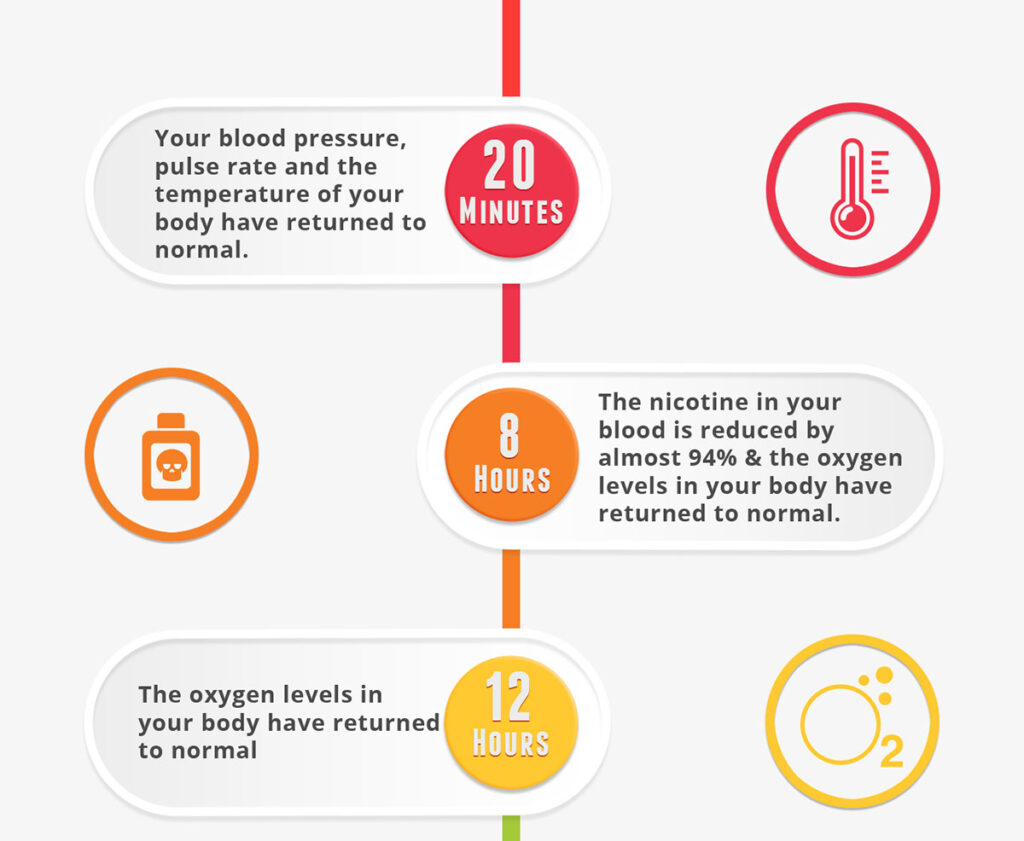
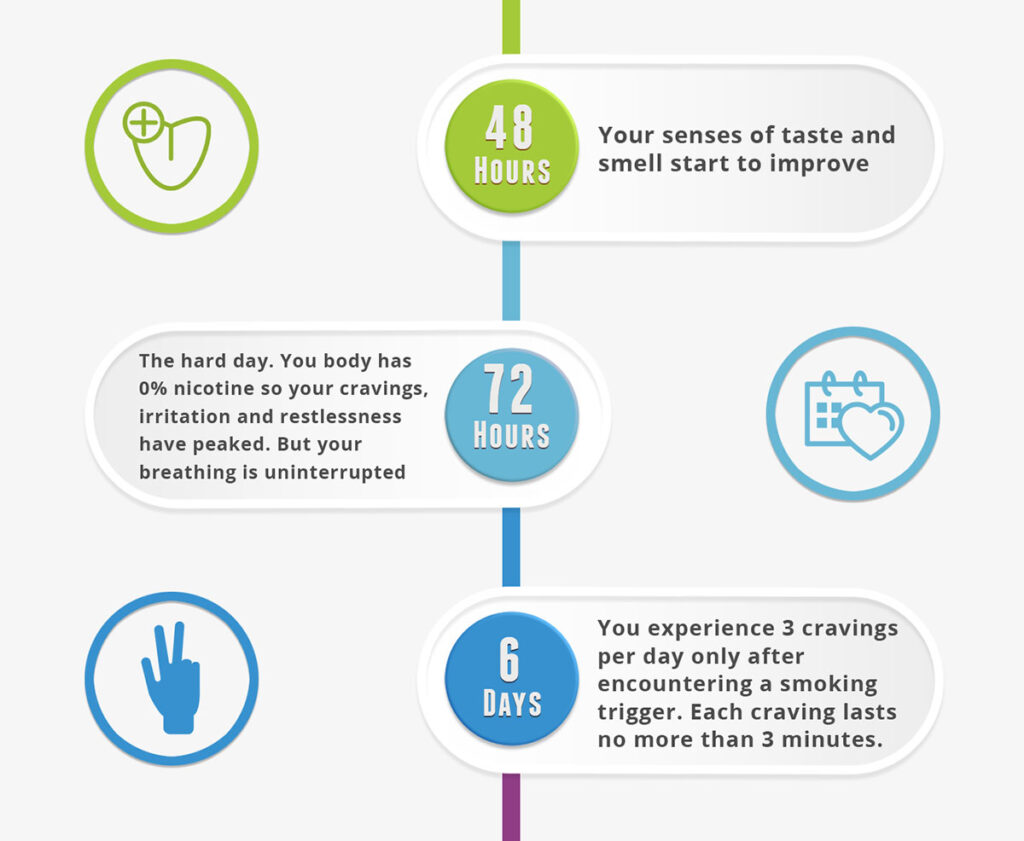
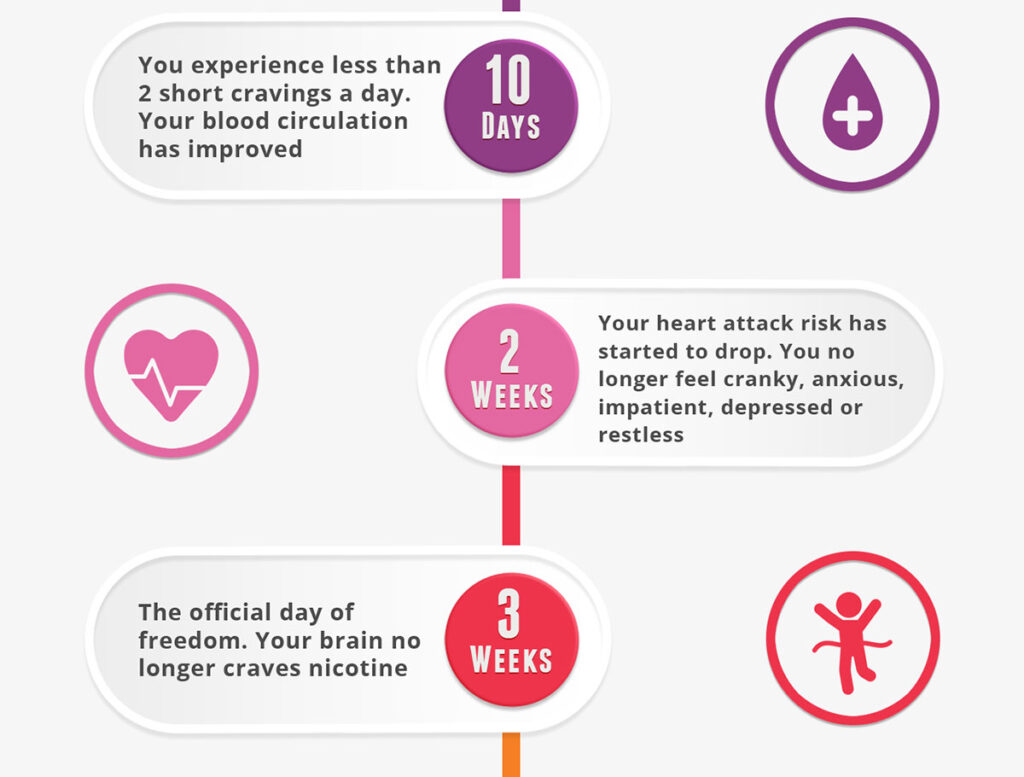
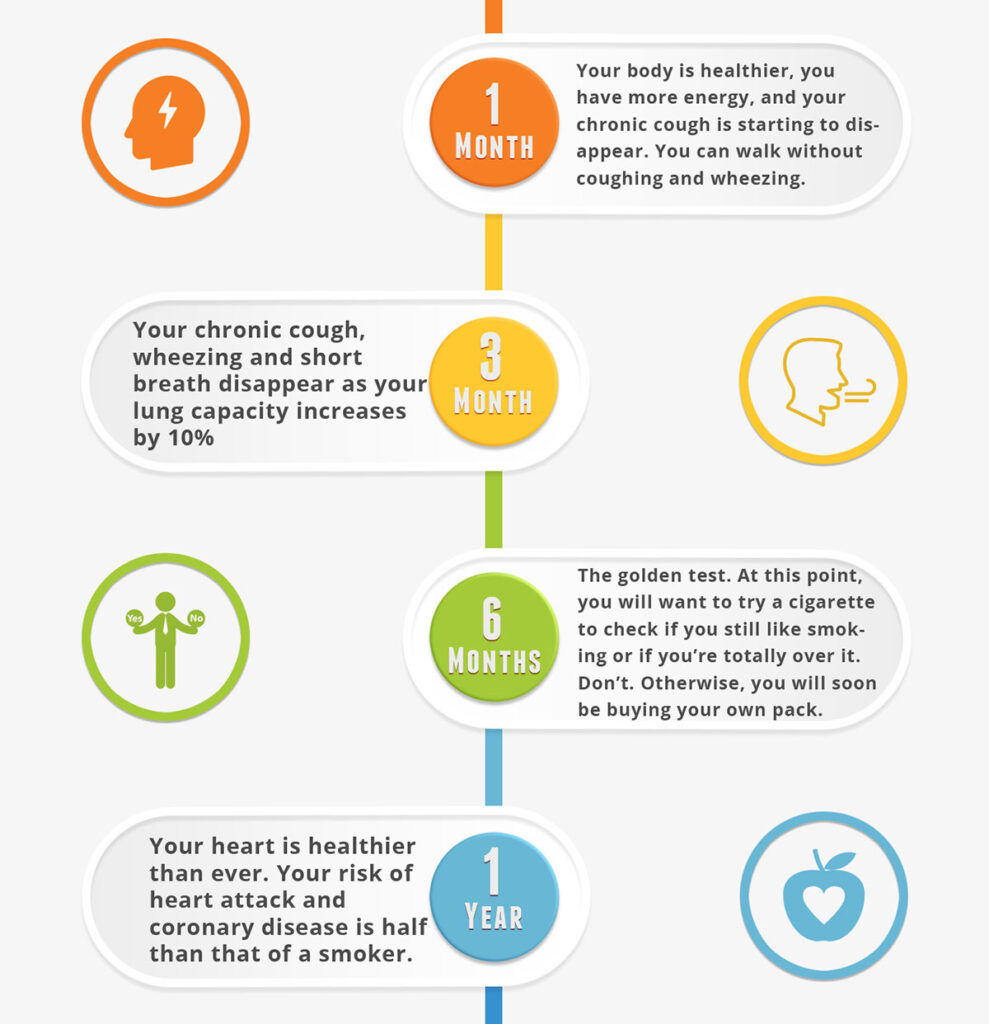
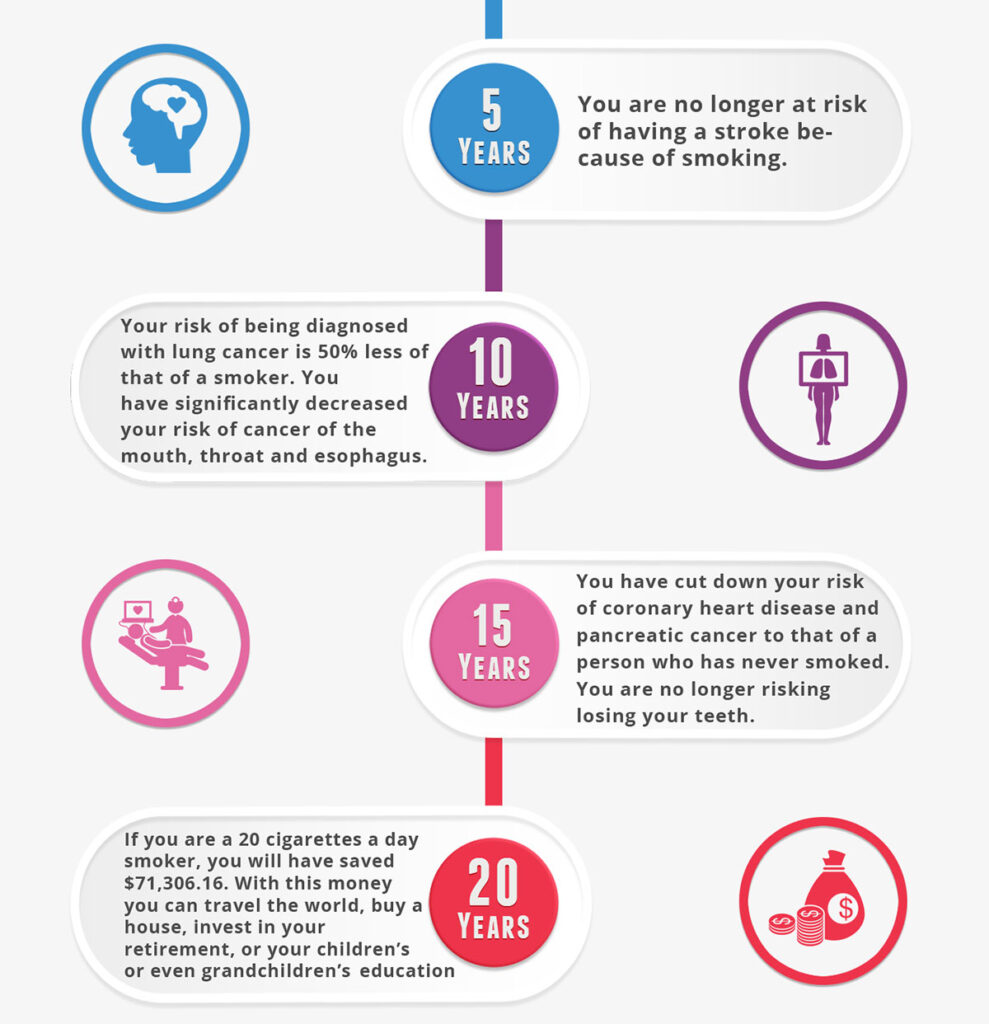
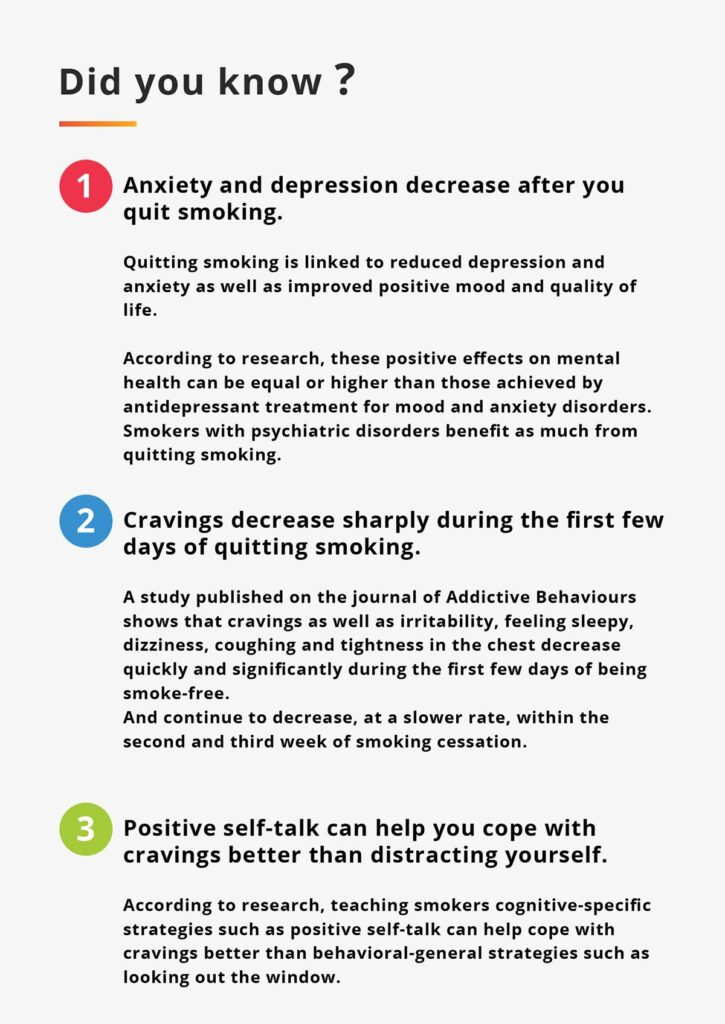
What Happens To Your Body When You Quit Smoking - A Detailed Timeline
Smoking is the leading cause of preventable death in our society. Cigarettes cause more deaths than HIV, illegal drugs, alcohol, car accidents and gun incidents combined because smokers are in higher risk to develop heart disease, stroke, and cancer almost everywhere in the body, like the bladder, esophagus, kidney, larynx, stomach and lungs.
The good news is that it’s never too late to turn your life around and adopt a healthier lifestyle. Quitting smoking will improve your health, quality of life and chances of living to old age with your family and loved ones.
There are long-term and almost instant benefits that you can experience after smoking your last cigarette. So here’s what happens when you quit smoking, a few hours later, a few days later, a few months later and a few years later.
20 minutes
Your blood pressure, pulse rate and the temperature of your body have returned to normal.
Researchers have found that smoking increases your blood pressure and heart rate. Nicotine stimulates your body making your heart beat faster and therefore work harder.
Within 20 minutes of quitting smoking, your heart rate and blood pressure are regulated again.
8 hours
The nicotine in your blood has reduced by almost 94%. That causes you to experience a craving.
12 hours
The oxygen levels in your body have returned to normal.
Carbon monoxide is one of the nearly 4,000 chemicals inside tobacco and decreases how much oxygen our blood can carry. According to BBC, carbon monoxide “combines with haemoglobin in red blood cells” which does not allow our red cells to carry as much oxygen.
The good news is that in just 12 hours after smoking your last cigarette, you increase your blood’s (and therefore, your body’s) oxygen capacity.
48 hours
Your senses of taste and smell have started to improve.
Smoking reduces your sense of smell by damaging the olfactory nerves that are located in the back of your nose. Also, tobacco harms your taste receptors and affects your sense of taste. As a result, smokers are less likely to enjoy the smell of flowers, rain, baked bread or scented candles as well as recognize the intensity of saltiness, bitterness, sweetness, and sourness.
72 hours
The hard day. Your body has 0% nicotine if you are a light or moderate smoker and close to 0% if you are a heavy smoker.
So your cravings, irritation, and restlessness have peaked. However, your breathing starts becoming smoother, and the cravings start decreasing in intensity, duration, and frequency.
Note that there are many factors affecting how long it takes your body to flush out the nicotine. Some include your age, genes, hormones, liver function and medications you might be taking.
6 days
You experience around 3 cravings per day, usually after encountering a smoking trigger. Each craving lasts no more than 3 minutes.
10 days
You experience less than 2 short cravings a day. Your blood circulation has improved.
The improvement of blood flow results in easier arousal and orgasms and a healthier sex life for both men and women.
2 weeks
Your heart attack risk has started to drop. You no longer feel cranky, anxious, impatient, depressed or restless due to the quit smoking side effects.
3 weeks
The official day of freedom. Your brain no longer craves nicotine as the brain receptors that have been affected by nicotine start to function in normal levels.
1 month
Your body starts regaining its health, and you feel you have more energy to work, walk and socialize. No more fatigues.
2 months
From the second week of your smoke-free life until this point, your immune system continues to improve helping you fight colds and flu.
3 months
Your chronic cough, wheezing and short breath have started to disappear as your lung capacity has increased by 10%. That 10% is critical considering that lung capacity naturally decreases with age and can be the difference between feeling great while taking a walk and coughing when climbing up the stairs.
6 months
The golden test. At this point, you will want to try a cigarette to check if you still like smoking or if you’re totally over it. Don’t. Otherwise, you will soon be buying your own pack.
1 year
Your heart is healthier than ever. Your risk of heart attack and coronary disease is half than that of a smoker.
Before the 5 year mark, your risk of developing cancer of the mouth, throat, esophagus, and bladder has dropped by half.
5 years
You are no longer at risk of having a stroke because of smoking. Within 2 to 5 years after quitting smoking, your risk for stroke may reduce to about that of a non-smoker’s.
10 years
Your risk of being diagnosed with or die from lung cancer is 50% less of that of a smoker. You have decreased your risk of cancer of the mouth, throat, and esophagus even more.
15 years
You have cut down your risk of coronary heart disease and pancreatic cancer to that of a person who has never smoked a cigarette in their life. You are no longer risking losing your teeth.
20 years
If you are a 20 cigarettes a day smoker, you will have saved $71,306.16. With this money, you can travel the world, buy a house or invest in your retirement and your children’s or even your grandchildren’s education!
Check exactly how much money you will save by quitting smoking.
What Happens to Your Mood and Cravings When You Quit Smoking
1. Anxiety and depression decrease after you quit smoking.
Quitting smoking is linked to reduced depression and anxiety as well as improved positive mood and quality of life.
According to quit smoking research, these positive effects on mental health can be equal or higher than those achieved by antidepressant treatment for mood and anxiety disorders. Smokers with psychiatric disorders benefit as much from quitting smoking.
During the first few days of the nicotine withdrawal, you might experience increased anxiety. That anxiety is caused by the withdrawal, and it’s a sign that your body is healing and adjusting without nicotine. The withdrawal anxiety will stop as soon as the nicotine withdrawal ends (3-5 days after you smoke your last cigarette) leaving you more relaxed as a non-smoker.
2. Cravings decrease sharply during the first few days of quitting smoking.
A study published on the journal of Addictive Behaviours shows that cravings as well as irritability, feeling sleepy, dizziness, coughing and tightness in the chest decrease quickly and significantly during the first few days of being smoke-free. And continue to decrease, at a slower rate, within the second and third week of smoking cessation.
3. Positive self-talk can help you cope with cravings better than distracting yourself.
This research showed that teaching smokers cognitive-specific strategies such as positive self-talk can help cope with cravings better than general behavioral strategies such as looking out the window.
